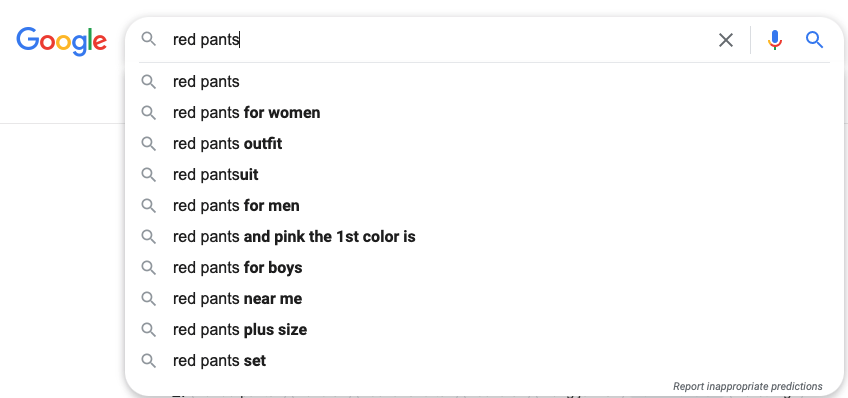Imagine how our ancestors would react if they saw the way we look for, find and consume information. Pretty sure they would be shocked.
Online search was a revolution from its very first beginnings. However, in the last few years, we’ve seen search evolved in ways we’d never seen before. From new UX approaches to cutting-edge AI technologies, new elements have emerged to bring search results to quality levels we had never seen before.
Among the most interesting areas of search, there’s a behavioral approach known as predictive search.
What is predictive search?
Predictive search is an online search approach that aims at anticipating the search needs of a user, by making suggestions related to their queries as they type in a search bar.
The final goal is to save time for the user by letting them click on the suggestions instead of forcing them to complete their queries. You might think the time it saves will not be substantial, but if we take all the search queries made globally every day, we are facing a full 200 years of search saved daily.
Predictive search core functionality, known as autocomplete, autosuggest, or find-as-you-type, has become mainstream and most website visitors expect search bars to provide it.
Are autocomplete and predictive search synonyms? We could say they are, but we’d like to think about predictive as the approach and about autocomplete as the feature or functionality. However, they are quite often interchangeable.
How does predictive search work?
Well, that is a tricky question.
Behind predictive search, there is usually an algorithm—or a few. For instance, in the case of Google, this is mainly based on popular searches including the keyword the user is typing in. This is the reason why, while adding new keywords, new, different suggestions appear.

Google predictive search
Google incorporates and privileges queries from the user’s past search history. This search algorithm works quite well for Google because they have tons and tons of data to base their suggestions on, but what happens when we apply this approach on websites lacking that type of data? Well, in many cases, search predictions fail to provide suggestions or display irrelevant recommendations.
Predictive search based on semantics
There are other approaches to build a successful predictive search, for instance, the use of semantic search, which tries to find the meaning or intent behind the query using contextual information.
So, let’s say we type in ‘red pants’ in the search bar of an online fashion store, but the brand is using the word ‘trousers’ in their product pages, and not ‘pants’.
Instead of focusing on the specific keyword, a semantic search engine with a predictive approach would suggest not only results including the keyword ‘pants’, but also those including synonyms like trousers, or even more specific words under the umbrella ‘pants’, for instance, chinos. Ultimately, this broadens the number of appropriate suggestions and increases the chances of the user to click on the suggested query.
Reasons to implement a predictive search engine
We’ve seen how predictive search works, but how does it help businesses?
Improving retention and conversion rates
Providing relevant results in a much faster way has tangible results in terms of helping visitors stay on your site longer and actually convert them into customers. Plus, the added value of search suggestions or autocomplete queries is that it gives a hint to visitors that there is relevant content behind that suggestion, so it encourages them to click.
Enhancing overall SEO
With customers staying longer on your pages, the bounce rate is drastically reduced, which creates a boost in SEO for your website.
Providing a better UX
No results are bad news. Predictive search not only cuts searching time but also reduces the chances of visitors getting a no results page, as it guides them to suggested content instead.
Strengthening brand loyalty
Happy customers are good customers. Reducing distractions, and improving findability make customers’ journey better and, in turn, it improves the way they see your brand, no matter the industry.
Increasing the findability of your content
Some pages might be buried under complex subpage structures and too difficult to find through navigation. Proper predictive search results will uncover products and content in the search suggestions to make them more easily accessible.
Implementing personalization
Predictive search can even leverage information from the visitor’s history to suggest queries they’ve searched before or products they have previously bought.
Fine-tuning predictive search for sales
Predictive search allows businesses to automatically suggest keywords or queries before the user even starts writing. This means that only by placing the cursor on the search box, they can already see suggestions. Businesses can use this to promote products on sales or having a huge amount of stock, bring specific topics into focus, or show the most common user queries.
Implementing predictive search with Inbenta
Predictive search is effortless, and we believe so should be its implementation.
Inbenta Search module is a plug & play tool that:
- Easily connects with your existing software. No need for creating new databases nor building or training models for long periods to achieve good search results. We can also pull data from other software like Salesforce, Zendesk, and other tools. You can find a list of them in our Integrations Hub.
- Crawls and indexes your existing content from every source you have in order for it to be accessible from our search engine.
- Can easily be customized to your color palette or branding guidelines so as to match your brand’s look and feel.
- Allows quick implementation, and can be up and running in just a matter of hours.










